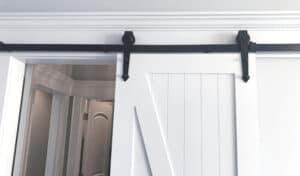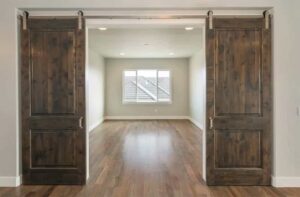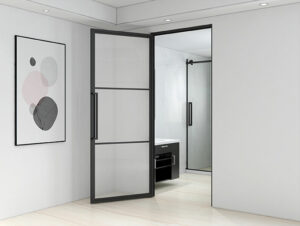Don’t overlook glass door hinges! They’re crucial for your door’s function and aesthetics. The right type means smooth operation and a great look for spaces like bathrooms and kitchens. This guide explores different hinges, like patch and pivot, to help you choose wisely.
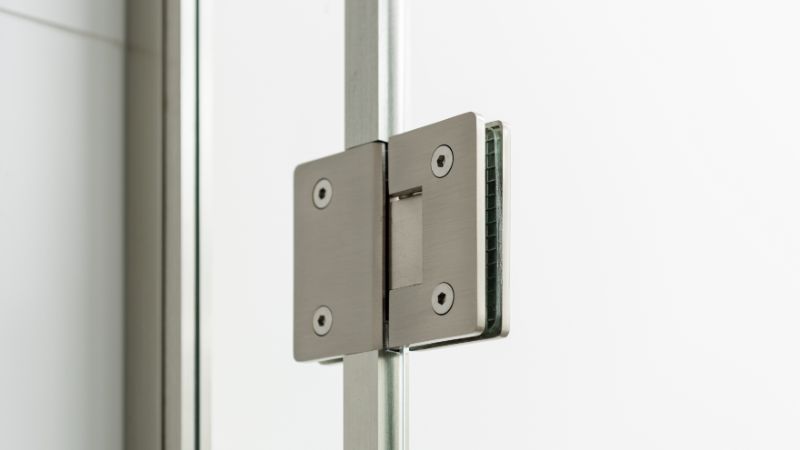
The Basics Of Glass Door Hinges
Glass door hinges are specialized hardware components designed to support and facilitate the movement of glass doors. Unlike standard door hinges, these are specifically engineered to accommodate the unique properties of glass, including its weight, fragility, and lack of frame in many applications.
The primary function of glass door hinges is to create a secure connection between the glass panel and the surrounding structure. They distribute weight evenly to prevent stress points that could lead to glass breakage.
Common Types of Glass Door Hinges:
- Pivot hinges
- Patch hinges
- Hydraulic hinges
- Concealed hinges
- Glass-to-glass hinges
Most glass door hinges are made from durable materials such as stainless steel, brass, or aluminum. These materials offer the necessary strength while resisting corrosion in bathroom environments.
The weight capacity is a crucial consideration when selecting glass door hinges. Heavier glass panels require hinges with higher load ratings to ensure safe and smooth operation.
Modern glass door hinges often feature self-closing mechanisms. These use spring tension or hydraulic systems to automatically return the door to a closed position after opening.
Installation methods vary by hinge type. Some require drilling holes in the glass, while others use clamps or adhesive mounting systems to avoid compromising the glass integrity.
Many glass door hinges offer adjustability in multiple directions. This allows for precise alignment during installation and makes it easier to correct any settling issues that might occur over time.
How Do Glass Door Hinges Work?
Glass door hinges operate on a simple yet ingenious mechanical principle that allows glass panels to swing open and closed smoothly. They typically consist of two plates – one attached to the door frame and another to the glass panel – connected by a pivoting mechanism.
The attachment to glass requires special consideration since drilling holes in glass can create weak points. Most glass door hinges use one of two mounting methods: clamp-style mounting or UV bonding.
Clamp-style hinges grasp the glass panel between metal plates, distributing pressure evenly to prevent breakage. These hinges don’t require drilling holes in the glass, making them a popular choice for many installations.
UV-bonded hinges attach to the glass using a special adhesive that cures under ultraviolet light. This creates an extremely strong bond without visible hardware, perfect for modern, minimalist designs.
The pivoting action of glass door hinges falls into several categories:
| Hinge Type | Movement Pattern | Common Applications |
|---|---|---|
| Pivot | Rotates around a fixed axis | Heavy glass doors, shower enclosures |
| Offset | Door swings away from the frame | Cabinet doors, display cases |
| Self-closing | Uses spring tension to close automatically | Bathroom doors, commercial spaces |
Weight capacity is another crucial factor in hinge functionality. Heavier glass panels require hinges with greater load-bearing capacity and often utilize additional support mechanisms.
Most quality hinges incorporate adjustment features that allow fine-tuning of the door’s alignment after installation. This ensures proper closure and prevents unwanted movement over time.
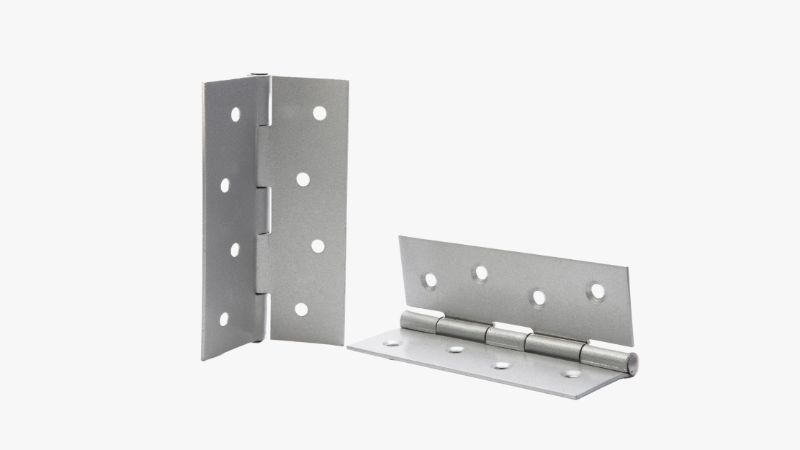
Types Of Glass Door Hinges
Glass door hinges come in various designs to accommodate different door configurations, glass thicknesses, and aesthetic preferences. Each type offers unique benefits for specific applications, from bathroom enclosures to commercial storefronts.
Pivot Hinges
Pivot hinges are among the most popular options for glass doors, supporting the door’s weight from both the top and bottom. They allow the door to rotate around a fixed axis, creating a smooth opening and closing motion.
These hinges work well for heavier glass doors as they distribute weight evenly. Most pivot hinges can support doors weighing up to 176 pounds, making them ideal for commercial applications.
Installation typically requires drilling into the floor and ceiling or header. Modern pivot hinges often feature adjustable components to fine-tune door alignment after installation.
Some pivot hinges offer self-closing mechanisms that gently pull the door closed after opening. This feature is particularly useful for bathroom enclosures and office spaces where privacy is important.
Full-Back Hinges
Full-back hinges (sometimes called continuous hinges) extend along the entire vertical edge of the glass door. They provide exceptional stability and support for medium to heavy doors.
These hinges attach to both the glass door and the adjacent wall or frame. The extended mounting surface distributes the door’s weight evenly across the entire height.
Key benefits include:
- Superior weight distribution
- Reduced stress on glass edges
- Enhanced stability during operation
- Sleek, uninterrupted appearance
Full-back hinges typically come in stainless steel, brass, or aluminum finishes. Many manufacturers offer customizable lengths to match specific door heights.
Most models support 3/8″ to 1/2″ glass thickness and can accommodate doors weighing up to 150 pounds.
Glass-To-Glass Hinges
Glass-to-glass hinges connect two glass panels at various angles, commonly used in shower enclosures and glass room dividers. These specialized hinges allow for creative architectural designs with all-glass structures.
They typically feature precision-cut notches in the glass panels where the hinge mechanisms attach. Most glass-to-glass hinges accommodate 135°, 180°, or 90° configurations.
Common types include:
| Type | Typical Use | Features |
|---|---|---|
| 180° | Inline panels | Creates flat surface |
| 90° | Corner installations | Forms right angle |
| 135° | Neo-angle enclosures | Creates pentagonal spaces |
These hinges usually require professional installation due to the precision needed for glass cutting. Most models include protective gaskets to prevent metal-to-glass contact that could damage the panels.
Offset Hinges
Offset hinges feature an asymmetrical design that shifts the pivot point away from the door edge. This offset allows the door to swing clear of the opening, maximizing available space.
These hinges are ideal for small bathrooms or tight spaces where every inch matters. They can provide an additional 1-2 inches of clearance in doorways.
Most offset hinges can be adjusted after installation to fine-tune the door’s positioning. This makes them popular for retrofit applications where perfect alignment is challenging.
The weight capacity typically ranges from 80-120 pounds depending on the model. They work best with lighter glass doors in residential settings.
Many offset hinges incorporate self-closing mechanisms with adjustable tension. This prevents doors from being accidentally left open.
No Drill Glass Door Hinges
No drill hinges offer a mounting solution that doesn’t require drilling holes in the glass. They use high-strength adhesives or clamp-style mechanisms to secure the door.
These hinges are perfect for temporary installations or situations where drilling glass isn’t feasible. They’re increasingly popular in rental properties and retail displays.
Most no-drill options can support doors up to 55 pounds, making them suitable for lightweight applications. Installation typically requires just cleaning the glass surface thoroughly before applying.
Popular varieties include:
- UV-bonded hinges (using special adhesives)
- Clamp-style hinges with protective gaskets
- Pressure-mount systems
While convenient, these hinges generally offer less stability than traditional drilled options. They work best for light-duty applications with minimal usage frequency.
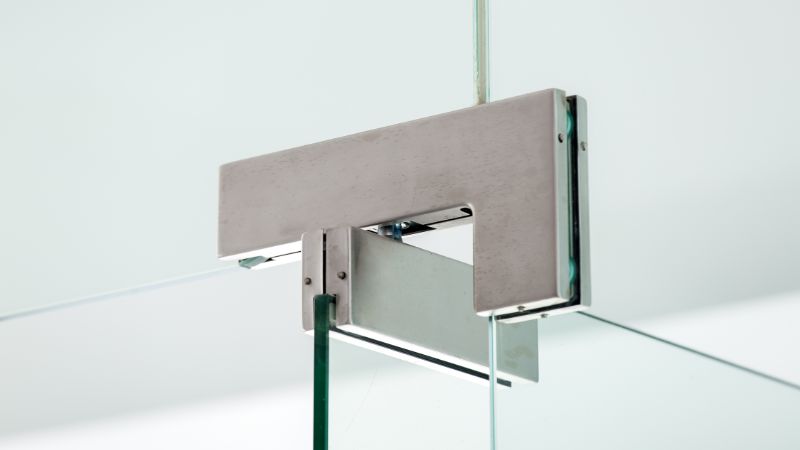
Advantages Of High-Quality Glass Door Hinges
High-quality glass door hinges offer exceptional durability compared to budget alternatives. They’re typically constructed from premium materials like solid brass, stainless steel, or high-grade aluminum that resist corrosion and wear over time.
These superior hinges provide smoother operation with precision engineering that eliminates sticking and squeaking. Many feature self-lubricating components that maintain consistent performance even after years of regular use.
Safety Benefits:
- Enhanced weight capacity for proper glass support
- Superior stability preventing door sag or misalignment
- Reliable holding power that prevents unexpected movement
- Precision alignment reducing stress on glass panels
Aesthetically, premium hinges complement luxury spaces with refined finishes and elegant designs. Options range from minimalist frameless styles to decorative statement pieces that enhance the overall door appearance.
Installation of quality hinges is typically more straightforward, with better engineering tolerances and clearer instructions. These precision-manufactured components align more easily and require fewer adjustments during setup.
Long-term cost savings become apparent when considering the extended lifespan of premium hinges. While initially more expensive, they require less frequent replacement and maintenance than cheaper alternatives.
Many high-end hinges incorporate advanced features like soft-close mechanisms and adjustable tension. These convenience features improve the daily user experience while protecting the glass from damage caused by slamming.
Proper Installation Of Glass Door Hinges
Installing glass door hinges correctly is crucial for both functionality and safety. Improper installation can lead to door failure, glass breakage, or even injuries to users.
Before beginning installation, gather all necessary tools including a drill, appropriate bits, screwdriver, level, measuring tape, and safety equipment. Always wear protective gloves and eyewear when working with glass.
Step 1: Measuring and Marking Precise measurements are essential for proper hinge placement. Mark hinge positions on both the glass panel and the frame, ensuring they align perfectly. For standard doors, hinges are typically placed 6 inches from the top and bottom edges.
Step 2: Preparing the Glass Glass panels require special preparation depending on the hinge type:
- Patch Fittings: Ensure proper cutouts are made by a professional glass fabricator
- Clamp-Style Hinges: Clean the glass surface thoroughly
- Through-Glass Hinges: Verify pre-drilled holes match the hinge specifications
Common Installation Pitfalls:
| Mistake | Consequence |
|---|---|
| Overtightening | Glass stress or breakage |
| Misalignment | Door dragging or binding |
| Inadequate support | Sagging and eventual failure |
Always follow manufacturer guidelines for torque specifications when tightening hardware. Using a torque screwdriver can prevent glass damage from excessive pressure.
Test the door’s operation several times after installation, making minor adjustments as needed. The door should swing smoothly without resistance or unusual sounds.
For heavier glass panels, consider using three hinges instead of two to distribute weight more evenly and extend the door’s lifespan.
How To Choose The Right Glass Door Hinge
Selecting the appropriate glass door hinge requires careful consideration of several factors. The right hinge will ensure smooth operation, durability, and aesthetic appeal for your glass door installation.
Weight capacity is perhaps the most critical factor. Determine the weight of your glass door and choose hinges rated to support that weight with a margin of safety.
Door thickness also matters significantly. Most residential glass doors range from 8mm to 12mm in thickness, while commercial applications may use thicker glass. Always check manufacturer specifications to ensure compatibility.
Opening direction will determine whether you need inswing or outswing hinges. This choice affects both functionality and space planning in your room layout.
Common Glass Door Hinge Types:
- Patch hinges (surface-mounted)
- Pivot hinges (floor and ceiling mounted)
- Hydraulic hinges (self-closing)
- Offset hinges (for flush installations)
Consider the environment where the door will be installed. For bathrooms or outdoor areas, stainless steel or brass hinges offer better resistance to moisture and corrosion.
The finish of your hinges should complement other hardware elements in the space. Popular options include brushed nickel, chrome, matte black, and bronze finishes.
For heavier doors or high-traffic areas, hinges with additional support features like reinforced mounting plates provide extra stability and longevity.
Budget considerations are important, but investing in quality hinges will save money long-term by preventing repairs and replacements.
Find Your Perfect Glass Door Hardware at Tengyu
Ready to upgrade your glass doors? Explore Tengyu’s premium range of Shower Hardwares and Glass Door & Partition solutions. For expert advice on choosing the perfect hinges and hardware for your project, don’t hesitate to contact us. Our team is here to help you find the ideal fit for both functionality and style!



